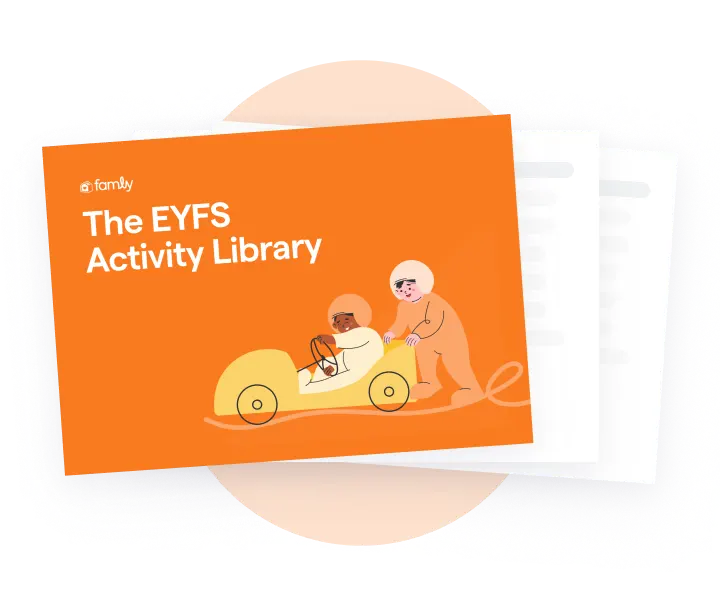settings
children
With Famly since
There is always a difference between what a child can do independently and what they can then do with some support (known as Vygotsky’s ‘zone of proximal development’). This is where scaffolding comes in, as it allows children to solve a problem or carry out a task that is beyond their current abilities.
With the right amount of assistance from you (the scaffolding), as well as their previously mastered skills, children can perform new activities and start gaining new skills.
Let's take a look at how it works.

The educator’s role
Scaffolding in the early years is really just about observing and providing suitable activities, whilst giving instructions, guidance, and feedback throughout. But it's how you provide support for children’s learning in a way that is well-timed and well-matched to the situation that matters.
Your role is also to observe the children, recognise the stage of learning they are at and then provide support to help them to reach the next stage. When children are given the support they need while learning something new or attempting a new activity, they will stand a better chance of using that knowledge independently.
What does scaffolding look like?
Traditionally, supporting children was all about telling a child how to do something until they got the knack of it. And of course, scaffolding may still require specific instructions from time to time. But in general, we now know that there are better ways to transfer your knowledge down to the little ones.
1. Open-ended questions
Providing open-ended questioning is one way to scaffold effectively. You’re helping advance the children’s thinking about what they're doing, but not giving away the entire solution. This might look like, "I wonder what might happen if we tried it this way... How could we make that work?"
2. Sustained shared thinking
Bouncing ideas and suggestions back and forth with a child, while engaging in sensitive questioning can help build that bridge between what they already know and what they are trying to grasp. Kathy Brodie explains it in more depth here.

3. Resources
Make the most out of additional resources in your setting. For example, if a child is finding it hard to draw a picture of a cat, ask them where they can find a cat somewhere else. This could be in a book that you have read recently, a drawing that another child has done, or a cuddly toy.
4. Prompts or suggestions
Using prompts is a great way to extend children’s thinking. They can be used in lots of ways, for example:
- Asking about a relevant topic – “Why do you think we use that…?”
- Asking for alternatives – “That‘s a good way of doing that, but is there another way we could try?”
- Providing support and working together – “Let’s have a think about this together.”
How to navigate the EYFS

5. Model and demonstrate
Help show your children what to do, or how to solve a problem, through modelling or demonstrating - not by outrightly telling them.
You then take a step back and only offer support when it’s needed. Modelling language can help children learn vital social skills like sharing, for example. An instance of this could be “Ellie, why don’t you tell Harry that you’d like a turn with the keyboard when he is finished.”
6. Feedback
Provide just the right amount of support and feedback, at the same time as giving plenty of encouragement. You can positively respond to both right and wrong answers, as this will encourage participation and resilience.

7. Step-by-step
Breaking the tasks into smaller steps can help children that are stuck. It’s a good idea to make sure that the first step involves something that children can already do, helping their confidence. Guide them through the following steps until they can eventually complete the whole task on their own.
8. Group work
Plenty of activities are best to do with a group of children, as they can then learn a lot from one another. Also, try not to create your groups of children only based on their abilities, as this will limit the scaffolding that can take place.

Your setting matters, too
Ensuring your early years setting is organised in a way that allows scaffolding to happen will make it easier for everyone.
The aim is to promote student success by supporting children's independent functioning. We want children to be interacting with their environment and the materials you provide, giving them opportunities to meet their own needs, solve their own problems, and make their own choices.
By exploring their surroundings in their early years, children develop new knowledge and connect it with their previous understanding. To make sure you’re ready for a day of scaffolding, you can ask yourself questions like:
- Have I created an inviting and appealing environment for children to learn in?
- Are there multiple ways a child can complete or engage with each activity?
- Are there enough open-ended resources and other materials to interest all the children in your class and encourage self-directed learning?
What about next steps?
The beauty of scaffolding is that the 'next step' of learning or development happens as you observe and interact with the child. A sensitive educator will extend and scaffold learning in the moment, sometimes called 'In The Moment' or emergent planning.
For example, A child might be working hard on building a ramp in the garden, while the educator asks questions and supports the exploration. The educator might then offer the child a new material or something to experiment with rolling up and down the ramp. They don't need to go inside and write up a next step for the child, as they facilitated it straight away.
The big ideas

Your setting matters, too
Ensuring your early years setting is organised in a way that allows scaffolding to happen will make it easier for everyone.
The aim is to promote student success by supporting children's independent functioning. We want children to be interacting with their environment and the materials you provide, giving them opportunities to meet their own needs, solve their own problems, and make their own choices.
By exploring their surroundings in their early years, children develop new knowledge and connect it with their previous understanding. To make sure you’re ready for a day of scaffolding, you can ask yourself questions like:
- Have I created an inviting and appealing environment for children to learn in?
- Are there multiple ways a child can complete or engage with each activity?
- Are there enough open-ended resources and other materials to interest all the children in your class and encourage self-directed learning?
What about next steps?
The beauty of scaffolding is that the 'next step' of learning or development happens as you observe and interact with the child. A sensitive educator will extend and scaffold learning in the moment, sometimes called 'In The Moment' or emergent planning.
For example, A child might be working hard on building a ramp in the garden, while the educator asks questions and supports the exploration. The educator might then offer the child a new material or something to experiment with rolling up and down the ramp. They don't need to go inside and write up a next step for the child, as they facilitated it straight away.
Try learning journals for free
Add observations, and build digital learning journals to share with families instantly. All with your completely free 14-day trial.
Get started









